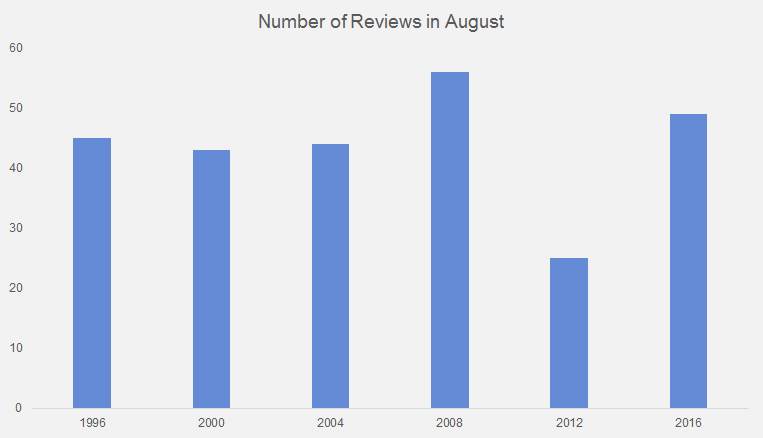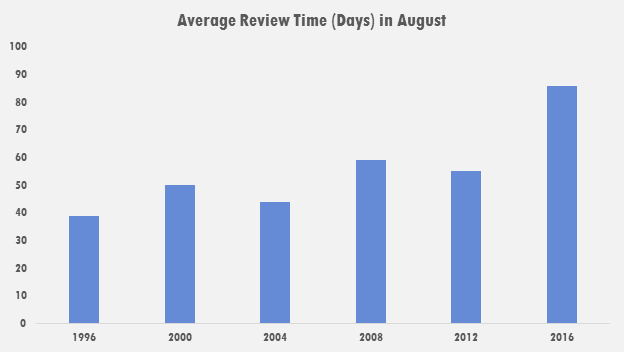Insight
September 8, 2016
Charting Midnight Regulation Before Dawn: August
The administration approved 49 regulations last month. Total regulatory costs hit $8.9 billion, with $1.3 billion in annual burdens, and more than 26 million paperwork burden hours. Despite this output, there does not appear to be a surge in regulation thus far.
In our series tracking regulation in the final year of the Obama Administration, this month once again proved the administration is on a record pace to issue significant regulation. Last month, the administration approved 15 significant rules and that figure declined to 12 in August, but it was still more than any comparable period in the past 20 years.
Through the first eight months of this year, regulators have approved 104 significant rulemakings; the next two closest years were 2008 and 2004, when regulators approved just 81 and 59 significant during the first eight months. In other words, the White House has approved 28 percent more significant regulatory action than any comparable period since 1996.
With less than a year for President Obama to regulate, this is his midnight year for regulation. Although it’s not the official midnight period yet (defined as the period after Election Day, but before the next president takes office), each month the American Action Forum (AAF) will highlight the final regulatory activity of the administration and compare it to similar times in the past. This monthly series will highlight all of the rules leaving the White House scheduled for official publication, all economically significant measures, the length of time for White House review, the number of rules rejected or withdrawn from the rulemaking process, and the monthly cost of federal regulatory activity.
August 2016
Once again, output in 2016 did not top previous presidential election years, but it was close in August. The highwater mark occurred in 2008, with the approval of 56 regulations; last month the administration approved 49 rules. The low-point was 2012, when the White House released just 25 rules. The chart below tracks overall regulatory activity during these midnight years.
However, for economically significant measures, August of 2016 led the way. OIRA concluded review of 12 significant measures; this compares to 11 significant rules in 2008, 10 in 2012, and nine in 1996. Below are just some of the notable regulations released last month:
- Conservation Standards for Coolers and Freezers
- GHG Standards for Heavy-Duty Trucks
- Conservation Standards for Cooking Products
- Heavy Vehicle Speed Limiters
- Head Start Performance Standards
Despite the output of 12 significant measures, there are still 26 economically significant measures pending review (as of this writing), so agencies continue to add notable rulemakings at the White House. In August, OIRA received 42 additional measures that are still pending review (including nine significant rules).
Once again, OIRA concluded review of several rules that had been under review for more than 120 days, which is the generally allowed timeframe for White House review under current executive orders. OIRA discharged ten rulemakings that had been under review for more than 120 days, including “Heavy Vehicle Speed Limiters,” which had been under review for 443 days.
August surpassed all other similar periods during presidential election years for average review times. The average review time last month was 86 days, compared to a low mean of 39 days in August of 1996. However, the outlier review time of 443 days, mentioned above, skewed the data. The median review time in August 2016 was a more pedestrian 68 days.
For comparison, the chart below tracks the average review time since 1996 during midnight years.
With regard to “withdrawn” rulemakings, or measures that agencies and OIRA pull back from review, there were two in August, both for substance abuse. There were three withdrawn measures in 2012, 2004, and 1996, two in 2008, and none in 2000. There is an obvious disincentive for agencies to withdraw rules this late during an administration and the White House has not aggressively pulled back regulations from review, at least compared to other similar periods.
The Cost
Thanks to AAF’s Reg Rodeo tool, the public can track regulatory costs and paperwork burdens over time, including data on major rules, Dodd-Frank, and the Affordable Care Act. In August 2016, regulators finalized $3.5 billion in costs, down from $5.9 billion in July. How does this compare to other similar periods? Although not a presidential election year, in August 2015, regulators published $2.2 billion in costs. In terms of paperwork, regulators published 25.2 million final hours this August, compared to August 2015, with 3.3 million hours.
Finally, there is the ultimate question of President Obama’s regulatory legacy. Through this point in his presidency (August of 2008), President George W. Bush had issued 434 major rules. By contrast, President Obama has issued 616, or 41.9 percent more than his predecessor. AAF will continue to publish monthly updates of similar periods in history.












